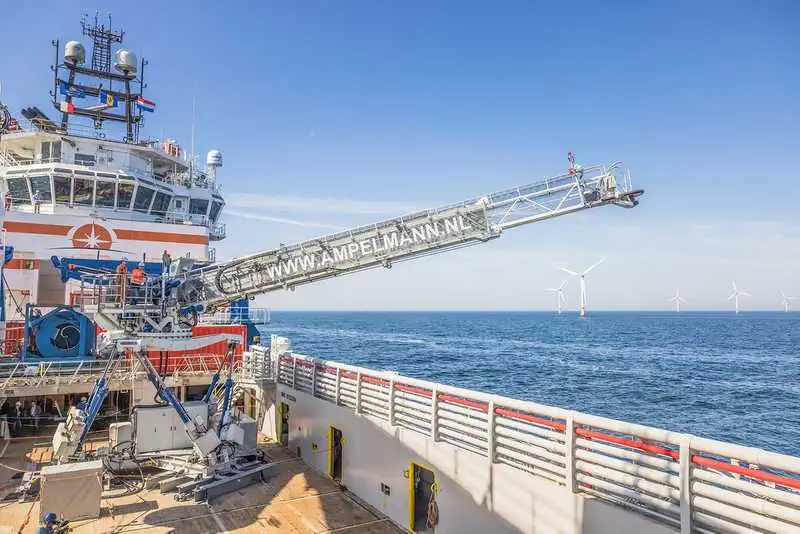Electric solutions, a lower carbon footprint and a strong commitment to sustainability are sure to be the future of the Walk to Work (W2W) industry. In line with that, Dutch offshore access provider Ampelmann, has announced the launch of an electric version of its signature A-type system.
Based on the technology and decade-long track record of its flagship system, the latest iteration of the A-type has seen its traditional hydraulic power train replaced by electric regenerative actuation, decreasing its energy use by more than 80%. This shift in technology does not only contribute to more environmentally friendly operations, but also makes the system significantly lighter, smaller in deck footprint and even quicker to mobilise.
The electric A-type is now fully operational after undergoing extensive offshore trials on the Horizon Star vessel in Eneco’s Princess Amalia wind farm.
“At Ampelmann, we are committed to driving our industry into a more sustainable future,” said CEO Jan van der Tempel. “The successful upgrade of the A-type to an electric system moves us directly towards that goal. This is a key milestone for our company as we continue to work towards new sustainable innovations.”
“This electric system is a significant step forward for our original A-type, which has been maintaining a stellar track record in the industry. The new iteration has improved plenty of important system specifications that are crucial in our journey towards more sustainable offshore operations”- JAN VAN DER TEMPEL, AMPELMANN
Smaller, lighter and more sustainable
The benefits of an electric W2W system are mostly two-fold. On the one hand, the electric A-type is smaller and lighter, requiring fewer resources to operate compared to its hydraulic-powered counterpart. Weight is reduced by 40% and energy use by 80%, considerably decreasing the environmental impact of the system without compromising workability specifications.
“With the implementation of electric drives, large heavy components of the hydraulic system became redundant, including the 20ft power pack container,” said Diederick Nierstrasz, Business Developer at Ampelmann. “Clients can expect the same capabilities as the non-electric A-type system, with an even higher reliability and ease of use.”
Additionally, Nierstrasz explains that the electric drives have improved the A-type’s accuracy and response time, while also eliminating the noise and vibrations the hydraulic-powered system used to produce.


Improved specifications and new possibilities on the horizon
In total, the change to electric actuation has led to an A-type with a smaller footprint, a reduction in weight and no need for an HPU on deck. The weight reduction of around 40% leads to plenty of added benefits as it makes the system suitable for smaller and lighter vessels and allows for higher vessel speeds.
In cooperation with Damen, Ampelmann has been taking steps towards the future of the offshore crew change market. The S-type, a newly designed system based on the technology of the electric A-type, is to be deployed on Damen’s new 7011 Fast Crew Supplier in Q3. The system, due to its improved specifications, is essential to the performance of the crew change operation. The new vessel is designed for a sailing speed of 40 knots, combined with a safe transfer of people in sea states up to 3m Hs in DP-mode. The combination of high transit speed and a high workability for people transfer makes this vessel a true game-changer for the marine crew change market.
The demand for safe, efficient, and sustainable crew change operations is growing in the offshore industry, and Ampelmann’s electric A-type answers to these demands. Van der Tempel considers its development therefore a great success. “This electric system is a significant step forward for our original A-type, which has been maintaining a stellar track record in the industry. The new iteration has improved plenty of important system specifications that are crucial in our journey towards more sustainable offshore operations.”











